Activism
1968, but really the 1960s generally, witnessed a turn towards activism, such as protests, demonstrations, strikes, sit-ins, teach-ins, riots, etc., designed to bring attention to wrongs endured by the people. Activism defined the break with the 1950s, when the tendency of intellectuals—at least in the United States—was to write and keep their mouths shut under the specter of McCarthyism. But all that changed in the 1960s, largely because of the inspiration of the Direct Action Movement (DAM), the term the Civil Rights movement gave to that phase of public contestation of segregation that began with the Montgomery Bus Boycott in 1955. The success of DAM in changing southern racial practices, especially nonviolently, inspired other oppressed groups and nationalities abroad, especially as the 1963 Birmingham and other demonstrations were disseminated widely through print media and television. Of course, the anti-Vietnam movement marshaled all of these street techniques as well as the media in such protests against the war. But for students, the key aspect of activism was first finding one's voice through public participation. By becoming activists, students felt in the 1960s that they had come alive, had come out of the cocoon of being passive recipients of Cold War ideologies, and had begun to choose for themselves what and how they would learn. In Nanterrre, French students rebelled against attempts by the administration to install neoliberal educational structures and expectations in the college curriculum. Of course, the chief power students wielded in the 1960s was the power to disrupt the operation of educational and other public institutions to bring attention to anomalies and travesties in the curriculum. As critics have noted, activism occurred for activism’s sake, without the requisite amount of forethought to make it effective. But much activism of 1968 innovated by showing that placing one’s body in public confrontation with undemocratic structures was often an effective way to challenge the status quo.
Criticality
Long simmering criticism of exploitive structures of power lay behind much public protest of 1968. Malcolm X is an icon of such criticality, even if his murder kept him from witnessing the flowering of many of his ideas in 1968. His speeches, many of which are available on YouTube, www.youtube.com/watch?v=Dmzaaf-9aHQ&feature=related showcase his laser-like ability to hone in on the hypocrisy of American democracy and maximize the contradiction between American ideals and American practice in its treatment of Black people. But less stereotypically militant figures were no less critical. Rosa Parks's refusal to give up her seat on a bus, thus launching the Montgomery Bus Boycott, emerged out of her critique of the social inequality of American life—a critique deepened by her study at the Highlander Folk School. Dolores Huerta's founding, with Caesar Chavez, of the United Farmworker's Union, emerged out of her critique of the class and racial exploitation of Mexican agricultural workers in California. In 1968, France perhaps offered to the world the other icon of criticality--the Situationists, a radical, anarchist aesthetic group, whose founders Guy Debord, Raoul Vaneigem, and Mustapha Khayati provided the intellectual gravitas for the May '68 rebellion in France in their trenchant essays, available at http://www.cddc.vt.edu/SIOnline/. To be critical was to be alive for those in 1968, to find in the language of critique a way of recreating one's subjectivity, to expose the contradictions and travesties of everyday life. To critique was to detach oneself from what is to imagine what could be. Of course, in criticality, there was always critique of critiques—people who argued that one's criticism did not go far enough, did not include those who were also disenfranchised, etc., thereby engaged in a spiral of criticism of all assertions that had the potential to become self-defeating. Nevertheless, less self-destructive criticism was crucial to student movements. In Mexico, the student and worker movements focused on the contradiction between the current political reality in Mexico and the ideals of the Mexican Revolution. In Paris, the student movement challenged the way the university and government officials wished to turn higher education into a preparation for participation in the American global market. Such critiques remain important today, as they focus attention on the way the educational policy operates today in the United States, Mexico, and France.
Community
Those engaged in the Black, French, and Mexican student movements argued that the student acted as a representative of a community. This sense of community spearheaded efforts by Black and Chicana/o students in the United States to demand a curriculum in American colleges and universities that was "relevant" to the needs and interests of their communities. Here, community most often meant the underrepresented racial and ethnic communities of 1968 who were, for the first time, being encouraged to send their most talented offspring to colleges and universities that made no place in their curriculum for sustained discussions of racism, class exploitation, colonialism, imperialism, sexism, homophobia, etc. These students wanted to retain ties with those working and lower middle class communities from which they came, communities that had nurtured in them a subjectivity that was less individualist and more collectivist in its thinking and aspirations than that which was common to the typical American teenager. In essence, what this new wave of ethnic American students represented was an American community undergoing change and demanding that its interests, its realities, its aspirations be reflected in higher education. Even more, these students, especially Black students, continued to learn from their communities of origin even after they arrived on historically-White university campuses. The year 1968 witnessed UC students going down to Watts to become “educated” not only in the conditions as lived there, but also in the “critique” that emerged from those in the ghetto, a critique of the American empire as it existed internally in America’s black and brown cities. Similarly, but differently, Paris ’68 became a major revolutionary movement only when it called for and was supported in a General Strike, when the students acted as representatives of a larger movement for change that included the working class. In Mexico, the Tlatelolco Massacre of students and workers may have taken place in part because students and workers were in solidarity against the government, and thus a bigger threat than students would have been alone. Not only did students see themselves as acting in the interest of a larger community, but students formed new and creative communities through their activism, as in the sense of community among Black students on predominantly White campuses, or solidarity between Black and Brown students struggling to change the curriculum at these same universities, or communities of activism between young radical White students and students of color in the anti-Vietnam War Movement or the Crisis University that was launched at UCSB in 1970. The idea that community was an antidote for the alienation of everyday life that capitalism fed upon to divide and conquer the populace was a powerful metaphor of 1968.
Aesthetics
In the late 1960s, a new generation of Black artists, curators, and theorists emerged to express a Black sensibility in the arts that responded to the three concepts mentioned above—an activist art, designed to transform consciousness about the identity of Black people in America; a political art that installed criticism of racism, class prejudice, gender bias, and everyday life in America as central to art making; and a communal art that argued that the proper source of inspiration for Black artists should be the Black community and not Western art traditions. Interestingly, this shift from the individual to the group, from the modernist to postmedium notions of art as communication, also took place in France with the Situationists, who argued that a new art must break with modernist infatuation with the art object. Art itself was decried as under assault if not destroyed by the commodification of all aesthetic practices by the market. In the United States, the popularity of “Happenings” echoed the idea of the Situationists that it was not the creation of objects but the situations in which aesthetic practices could be incorporated into daily life that were really important. Similarly, Black, Chicana/o, and Mexican art moved in the direction of performance art, just as music became a repository of political memory. Most important, art and music became those arenas where the new was imagined while the old was critiqued. In that sense, the most forward-looking interrogations of the now can be found in the aesthetic archive of 1968.
|
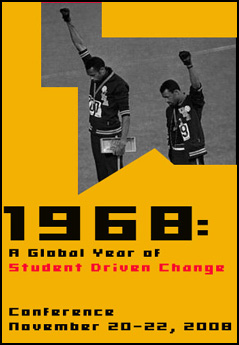
1968 Conference Poster
Click for larger view
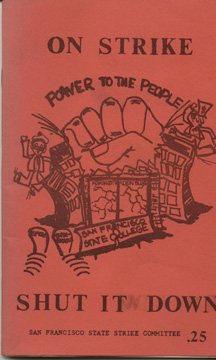
ON STRIKE - SHUT IT DOWN
Strike Committee Booklet
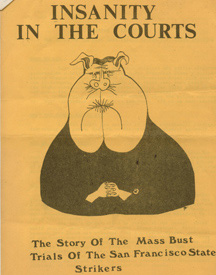
INSANITY IN THE COURTS
Mass Arrest Pamphlet
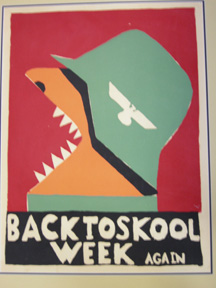
BACK TO SKOOL WEEK Again
Poster
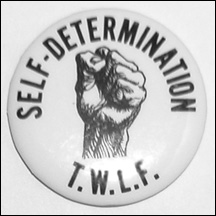
SELF-DETERMINATION
T.W.L.F. Button
|
|
Education
In 1968, U.S., French, and Mexican universities witnessed some of the most dramatic strikes, demonstrations, and, ultimately, changes in their histories. From culture wars to police riots, the university became a contested space, one in which the function of education and the student changed in some profound ways, never to turn back to what they had been before.
Some of the changes that occurred during this time:
- Students sought to revise the student-teacher relationship, such that students could become educators and teach professors what they felt was important for them to learn. This overturned the traditional teacher student relationship by which teachers are the actors and the students are the passive recipients of knowledge.
- The curriculum changed in response to the demand for Black Studies, Chicano/a Studies, and Women’s Studies, as part of a larger critique of the "universalist" nature of the knowledge the disciplines traditionally presented to students. History became problematized as his/story as the demand to present her/story, something that had typically been ignored in the traditional canon, took on new importance. This, along with the changes brought about by the creation of Black and Chicano/a Studies, led to the demand that professors provide multiple points of views on issues.
- Students were educated outside of the classroom, in teach-ins about the Vietnam War, Black Student Union meetings, and trips to the "Ghetto." Self-trained scholars would often present an alternative or what Foucault would call "subjugated knowledges" to students who brought those knowledges and perspectives back to the universities. A kind of "bottom-up" process of knowledge formation occurred in Black and Chicano/a Studies, as those who were living in the social conditions of the ghetto articulated a critique of university education that students brought into the classroom.
- Students experienced a great deal of excitement about learning, especially when they became activists, as the normal segregation of knowledge in the economy that argues that scholarship and activism are oxymorons was critiqued. Often, students became more interested in their studies when they could apply what they were learning to the political events unfolding in their world. This led some professors to adopt a different approach to teaching—one in which students in class were seen as resources or reservoirs of knowledge for the entire educational experience in the classroom.
- Former students and activists became teachers in the university and brought into the curriculum perspectives and subject matter--such as courses on African Liberation movements--that had never been in the curriculum before.
Expanding on the changes that occurred in 1968 in the areas of activism, criticality, community, aesthetics, and education, the following questions will hopefully create additional opportunities for meaningful discussion both during and after the conference.
- Students were often the more innovative, more cutting-edge thinkers in relation to traditionally-educated professors. How did Black Studies revise the student-teacher contract, and overturn the traditional teacher-student relationship by which teachers are the actors and the students are the passive recipients of knowledge? How did Chicano/a and Women’s Studies similarly re-imagine the relationship between students and teachers? Black and Chicano/a Studies emerged out of a pedagogy that asserted students and teachers were co-creators of knowledge. Has that pedagogical innovation persisted in Black and Chicano/a Studies as they have become institutionalized in the academy? What has happened to the "bottom-up" process of knowledge formation that launched these fields of study? In particular, how have Black students changed in how they regard or in what they want from Black Studies since 1968?
- What role did the Black community play in starting/influencing Black Studies Departments and Programs? For example, at UCLA, many of the Black Students behind the formation of Black Studies had spent time in Watts, imbibing radical critique from activists in the Black community. What has happened to that relationship in the 40 year evolution of Black Studies since 1968? To what extent does Black Studies today retain a relationship with the Black community? To what extent are the concerns of the working and middle class in the Black community reflected in the Black Studies curriculum? And if these concerns have not been adequately represented, what has been gained in the process? What has been lost? Does a critique which posits higher education as part of the colonial process survive today in Black Studies programs/departments? What about in Chicano/a Studies programs/departments?
- How did 1968 challenge the conventional notion that scholarship and activism are polar opposites? To what extent did activism, immersion in community issues, and conflicts between working and middle class blacks in Black Studies colloquia and meetings heighten and enliven the creation of knowledge in 1968? Has that tension, interaction, and contestation declined in most Black Studies Programs and Departments today? Can this kind of tension, interaction, and contestation be seen in other programs and departments, such as in Chicano/a and Women’s Studies?
- In 1968, the protests on the UCSB campus—the takeover of the computer building—led to the creation of the Black Studies Department, the Center for Black Studies Research, and the Chicano/a Studies Department. In other words, the activism of Black Students created an opening for Chicano/a Studies to emerge on the UCSB campus. What happened to the relationship between these two entities after 1968? To what extent do Black Studies and Chicano/a Studies engage in dialogue on a regular basis today?
- In the 1980s, a shift occurred towards Afrocentrism and towards documenting the persistence of African-centered ways of knowing in the United States and the Western Hemisphere. Did Black Studies blossom or suffer in the transition to Afrocentrism? Why? To what extent did the shift to Afrocentrism in Black Studies Departments and Programs reflect a wider growth of African self-consciousness, African material objects as commodity culture, and Afrocentricism in hip hop music of the 1980s?
- What was gained or lost when the neoconservatives succeeded in framing Black Studies, Women Studies, Chicana/o Studies as identity politics? What were the costs of the internal part of that problematic, by which skin-color nationalism began to influence decisions of who was qualified to teach Black Studies? For example, in the 1960s, the most Black Studies-oriented courses in American history were taught by Ronald Takaki, a Japanese American and professor of Ethnic Studies at UC Berkeley. Later, he went on to teach the history of Asian American experience, and Black history was taught by African American historians. What impact did the withdrawal of many radical White participants from Black Studies have on the continued evolution of Black Studies as a site of radical critique of the American institution of higher education? What role did the emergence of the neoconservative critique of identity politics in the 1980s play in empowering or decentering Black Studies critique?
- What role did the rise of the Black Women's Renaissance of the 1980s play in the revitalization of Black Studies? Likewise, in what ways did the Chicana literary movement of the 1980s and 90s impact Chicano/a Studies? What aspects of Black and Chicano/a Studies hegemonic structures were overturned with the publication of foundational literary texts by African American women novelists such as Toni Morrison and Alice Walker, and Chicana feminists like Sandra Cisneros and Gloria Anzaldúa? Did the Black Women's Renaissance, and its problematizing of gender and sexism in Black Nationalist politics, help Black Studies exit the cul-de-sac of Afrocentrism? To what extent did identity politics create an internal hegemony of intra-group domination in the misogyny of much Black Nationalist discourse undergirding Black Studies? Similarly, to what extent did identity politics reinforce the entrenched patriarchal values of Mexican culture which formed the backdrop for gender discourse in Chicano/a Studies?
- In the 1990s, a shift occurred in some departments, such as at Harvard University, towards eschewing Afrocentrism and advancing Black professionalism as the core of Black studies. To what extent did Black Studies professionalism reflect the need of corporate America to induct Black middle class talent into the pipeline? If we think of this shift as part of the original economic underpinning of the academy's willingness to incorporate Black Studies into the curriculum, does this process suggest Black Studies exemplifies the incorporation of Blacks as middle class workers in a post-Fordist, service economy?
- How does this process compare/contrast with the experience of youth in Mexico City in 1968, which demanded democratic rights through street protest similar to that of the students in the Black Student Unions? In what sense did the ruthless repression of the people by the Mexican government in the famous Tlatelolco massacre on the eve of the 1968 Summer Olympics highlight a fundamental obstacle to the radical evolution of student movements like Black Studies? That is, if social movements actually challenged established political power, would they be ruthlessly crushed? Or does Mexico highlight the fundamental contradiction of education: students are asked to educate themselves to become leaders, but when they take leadership positions, they are repressed? Was the repression of Black Studies less intense than in Mexico City because Black Studies did not challenge, ultimately, the fundamental structure of power in education? Was the Black Studies challenge ultimately contained?
- How did the creation of Black Studies, the Mexican student rebellion, and the Paris uprisings renegotiate the relationship between students and the emerging global economy? What were American universities, Paris universities, and Mexican universities preparing students to do or become in 1968? If the global economy was entering a post-Fordist, service industry, what did Black Studies prepare students to do in the wake of 1968? What do these institutions prepare people to do today?
- Did the Paris rebellion of students transform French life fundamentally? How? What has been left undone? Why do we witness the rise of racism and anti-immigrant fervor in France today?
- Did the creation of Black Studies, the Mexican student rebellion, and the Paris student uprising change what students are expected to know as college graduates? How have the successes/failures differed among these three national struggles?
|
|
|